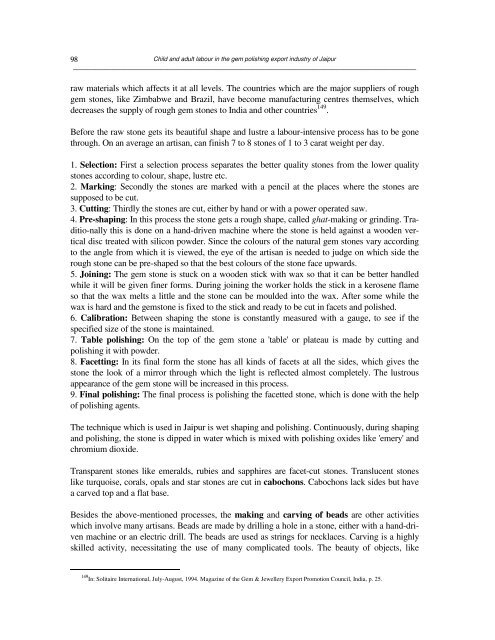You also want an ePaper? Increase the reach of your titles
YUMPU automatically turns print PDFs into web optimized ePapers that Google loves.
98<br />
<strong>Child</strong> <strong>and</strong> <strong>adult</strong> <strong>labour</strong> <strong>in</strong> <strong>the</strong> <strong>gem</strong> polish<strong>in</strong>g <strong>export</strong> <strong>in</strong>dustry <strong>of</strong> Jaipur<br />
──────────────────────────────────────────────────────────────────────────────────────────────<br />
raw materials which affects it at all levels. The countries which are <strong>the</strong> major suppliers <strong>of</strong> rough<br />
<strong>gem</strong> stones, like Zimbabwe <strong>and</strong> Brazil, have become manufactur<strong>in</strong>g centres <strong>the</strong>mselves, which<br />
decreases <strong>the</strong> supply <strong>of</strong> rough <strong>gem</strong> stones to <strong>India</strong> <strong>and</strong> o<strong>the</strong>r countries 149 .<br />
Before <strong>the</strong> raw stone gets its beautiful shape <strong>and</strong> lustre a <strong>labour</strong>-<strong>in</strong>tensive process has to be gone<br />
through. On an average an artisan, can f<strong>in</strong>ish 7 to 8 stones <strong>of</strong> 1 to 3 carat weight per day.<br />
1. Selection: First a selection process separates <strong>the</strong> better quality stones from <strong>the</strong> lower quality<br />
stones accord<strong>in</strong>g to colour, shape, lustre etc.<br />
2. Mark<strong>in</strong>g: Secondly <strong>the</strong> stones are marked with a pencil at <strong>the</strong> places where <strong>the</strong> stones are<br />
supposed to be cut.<br />
3. Cutt<strong>in</strong>g: Thirdly <strong>the</strong> stones are cut, ei<strong>the</strong>r by h<strong>and</strong> or with a power operated saw.<br />
4. Pre-shap<strong>in</strong>g: In this process <strong>the</strong> stone gets a rough shape, called ghat-mak<strong>in</strong>g or gr<strong>in</strong>d<strong>in</strong>g. Traditio-nally<br />
this is done on a h<strong>and</strong>-driven mach<strong>in</strong>e where <strong>the</strong> stone is held aga<strong>in</strong>st a wooden vertical<br />
disc treated with silicon powder. S<strong>in</strong>ce <strong>the</strong> colours <strong>of</strong> <strong>the</strong> natural <strong>gem</strong> stones vary accord<strong>in</strong>g<br />
to <strong>the</strong> angle from which it is viewed, <strong>the</strong> eye <strong>of</strong> <strong>the</strong> artisan is needed to judge on which side <strong>the</strong><br />
rough stone can be pre-shaped so that <strong>the</strong> best colours <strong>of</strong> <strong>the</strong> stone face upwards.<br />
5. Jo<strong>in</strong><strong>in</strong>g: The <strong>gem</strong> stone is stuck on a wooden stick with wax so that it can be better h<strong>and</strong>led<br />
while it will be given f<strong>in</strong>er forms. Dur<strong>in</strong>g jo<strong>in</strong><strong>in</strong>g <strong>the</strong> worker holds <strong>the</strong> stick <strong>in</strong> a kerosene flame<br />
so that <strong>the</strong> wax melts a little <strong>and</strong> <strong>the</strong> stone can be moulded <strong>in</strong>to <strong>the</strong> wax. After some while <strong>the</strong><br />
wax is hard <strong>and</strong> <strong>the</strong> <strong>gem</strong>stone is fixed to <strong>the</strong> stick <strong>and</strong> ready to be cut <strong>in</strong> facets <strong>and</strong> polished.<br />
6. Calibration: Between shap<strong>in</strong>g <strong>the</strong> stone is constantly measured with a gauge, to see if <strong>the</strong><br />
specified size <strong>of</strong> <strong>the</strong> stone is ma<strong>in</strong>ta<strong>in</strong>ed.<br />
7. Table polish<strong>in</strong>g: On <strong>the</strong> top <strong>of</strong> <strong>the</strong> <strong>gem</strong> stone a 'table' or plateau is made by cutt<strong>in</strong>g <strong>and</strong><br />
polish<strong>in</strong>g it with powder.<br />
8. Facett<strong>in</strong>g: In its f<strong>in</strong>al form <strong>the</strong> stone has all k<strong>in</strong>ds <strong>of</strong> facets at all <strong>the</strong> sides, which gives <strong>the</strong><br />
stone <strong>the</strong> look <strong>of</strong> a mirror through which <strong>the</strong> light is reflected almost completely. The lustrous<br />
appearance <strong>of</strong> <strong>the</strong> <strong>gem</strong> stone will be <strong>in</strong>creased <strong>in</strong> this process.<br />
9. F<strong>in</strong>al polish<strong>in</strong>g: The f<strong>in</strong>al process is polish<strong>in</strong>g <strong>the</strong> facetted stone, which is done with <strong>the</strong> help<br />
<strong>of</strong> polish<strong>in</strong>g agents.<br />
The technique which is used <strong>in</strong> Jaipur is wet shap<strong>in</strong>g <strong>and</strong> polish<strong>in</strong>g. Cont<strong>in</strong>uously, dur<strong>in</strong>g shap<strong>in</strong>g<br />
<strong>and</strong> polish<strong>in</strong>g, <strong>the</strong> stone is dipped <strong>in</strong> water which is mixed with polish<strong>in</strong>g oxides like 'emery' <strong>and</strong><br />
chromium dioxide.<br />
Transparent stones like emeralds, rubies <strong>and</strong> sapphires are facet-cut stones. Translucent stones<br />
like turquoise, corals, opals <strong>and</strong> star stones are cut <strong>in</strong> cabochons. Cabochons lack sides but have<br />
a carved top <strong>and</strong> a flat base.<br />
Besides <strong>the</strong> above-mentioned processes, <strong>the</strong> mak<strong>in</strong>g <strong>and</strong> carv<strong>in</strong>g <strong>of</strong> beads are o<strong>the</strong>r activities<br />
which <strong>in</strong>volve many artisans. Beads are made by drill<strong>in</strong>g a hole <strong>in</strong> a stone, ei<strong>the</strong>r with a h<strong>and</strong>-driven<br />
mach<strong>in</strong>e or an electric drill. The beads are used as str<strong>in</strong>gs for necklaces. Carv<strong>in</strong>g is a highly<br />
skilled activity, necessitat<strong>in</strong>g <strong>the</strong> use <strong>of</strong> many complicated tools. The beauty <strong>of</strong> objects, like<br />
149 In: Solitaire International, July-August, 1994. Magaz<strong>in</strong>e <strong>of</strong> <strong>the</strong> Gem & Jewellery Export Promotion Council, <strong>India</strong>, p. 25.


















